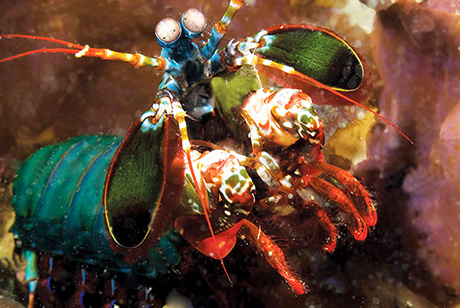Mantis Shrimp MagicContents of this Issue: Cuba, by Land and by Liveaboard Dolphins in Grand Turk Home Swimming Pools? Deep Vein Thrombosis and Decompression Sickness Raja Ampat; The Top Resorts and Liveaboards The Misplaced Optimism of Some Camera Manufacturers California Great White Shark Population on the Rise A Tragically Glamorous Underwater Shoot Why So Many Maui Shark Attacks? Climate Change Wreaks Havoc on Coral Nine Million Dollar Wrongful Death Lawsuit Editorial Office: Ben Davison Publisher and Editor Undercurrent 3020 Bridgeway, Suite 102 Sausalito, CA 94965 from the July, 2016 issue of Undercurrent
The mantis shrimp is big. Typically it can be around eight inches long. Some are even bigger. Tropical divers are familiar with them and their compelling ability to smash the shells of prey with a fist-like limb. Yet few know that it is inspiring research into everything from cancer-detecting technology and polarized lenses to strong and lightweight composite materials. That fist, or 'dactyl club,' can accelerate to 50 mph in just three-thousandths of a second, moving so fast it boils the water in its path. It creates a sonic shockwave that can kill or stun small prey that come too close. However, it needs to be exceptionally tough to do that. For example, its "periodic region," at the internal portion of the club, has spiral-shaped structures that act as tiny shock absorbers soaking up energy.
Now, scientists at the University of California Riverside have discovered another region the outerportion of this dactyl club, an extraordinary crack-resistant herringbone structure (called the impact region) that protects the mantis as it attacks its prey. This region is composed of crystalline calcium phosphate (also found in human bone) that envelops organic chitin fibers, which are pressed together to create a herringbone pattern that is notably harder than that of the periodic region. The unique structure allows the mantis shrimp to inflict significant damage to its prey by transporting higher momentum upon impact. Stress can be distributed more equally, lessening disastrous structural collapse. Understanding the mantis shrimp's structure is helping scientists to develop new super-strong materials for aircraft, armor, protective helmets and the like, all based on the small, colorful crustacean and the magic of the mantis shrimp. |

I want to get all the stories! Tell me how I can become an Undercurrent Online Member and get online access to all the articles of Undercurrent as well as thousands of first hand reports on dive operations world-wide
| Home | Online Members Area | My Account |
Login
|
Join
|
| Travel Index |
Dive Resort & Liveaboard Reviews
|
Featured Reports
|
Recent
Issues
|
Back Issues
|
|
Dive Gear
Index
|
Health/Safety Index
|
Environment & Misc.
Index
|
Seasonal Planner
|
Blogs
|
Free Articles
|
Book Picks
|
News
|
|
Special Offers
|
RSS
|
FAQ
|
About Us
|
Contact Us
|
Links
|
3020 Bridgeway, Ste 102, Sausalito, Ca 94965
All rights reserved.


